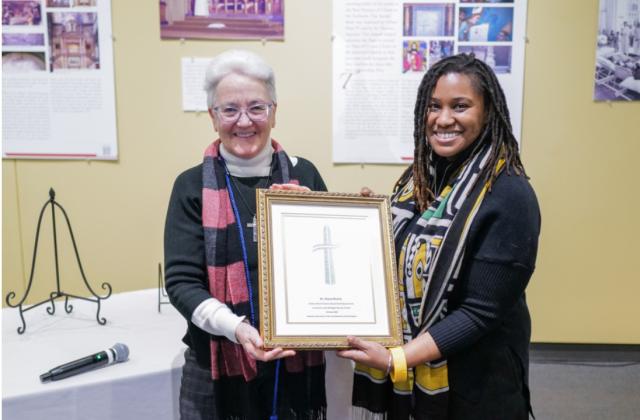The recent terrible flooding in Florissant, Missouri, is the continuation of a pattern that goes back centuries. In the early years of Rose Philippine Duchesne’s residence in Florissant, in order to get to the convent for Mass, the priest had to travel some distance across one of the two streams that surrounded the property (which is today the Old Saint Ferdinand Shrine). She wrote in the house journal in August of 1824:
The bad weather made the two streams that surround us and do not have bridges to swell, and made it very dangerous for the father superior to get to the church. He often had to swim across on his horse or on a tree.
On September 1 that year, she gave a vivid report to Madeleine Sophie Barat:
Although there are several priests, they will not want to lodge near the house, and if they stay where they are, the difficulty of travel is major. We are between two streams that have swollen so much this year that our garden and our poultry yard just formed a lake. The little bridges and our fence have been taken away several times. In order to go or return, the father had to make his horse swim, while he crossed on a moving tree trunk. One day, we saw the horse arrive alone without its saddle. We looked in terror for fear that the father had stayed in the water. Finally he appeared, soaked up to his ears. His horse had thrown him. His saddle was found by a young man, who offered it to him in an insolent tone: “What will you give me to give it back to you?” These are the manners of the parishioners, their contribution and gratitude.
Two years later, it was happening again. She wrote on June 15, 1826:
A week ago, two streams flooded and carried away our fence and a bridge, destroyed our garden, etc. We have never seen the water rise so high. The children in the school had to sleep on the first floor (above the ground floor), since their classroom, where they ordinarily sleep, was flooded to a depth of three or four feet. We have had great anxiety about the school house that is made of wood, elevated on four posts, so that it has water not only under it but even inside; it could easily collapse. Our big house was dry but surrounded by water on all sides, as was the church. We were almost at the point of not being able to light a fire, for lack of wood, which the water made float around on every side.
Philippine often reported about ongoing flooding. She writes about it again in 1835 from City House in neighboring St. Louis, and 1843 from St. Charles. The next year, she wrote from her retirement in St. Charles to her former novice, Adeline Boilvin, then superior at McSherrystown, Pennsylvania, on September 15, 1844:
God makes trials succeed so that all will be done slowly. After a flooding, the likes of which we have never seen, which has ruined the countryside, has come sickness that lasts and reduces families that have already lost house, furniture, animals, and harvest to the most frightful misery; and no one here is sufficiently well off to give alms. They did it more in Saint Louis; there are certain people who are not rich but who have welcomed up to 7 sick families that came from Illinois at the time of the flood, and wanted to provide for all their needs for six months.
Photo by Lukas Hron on Unsplash




